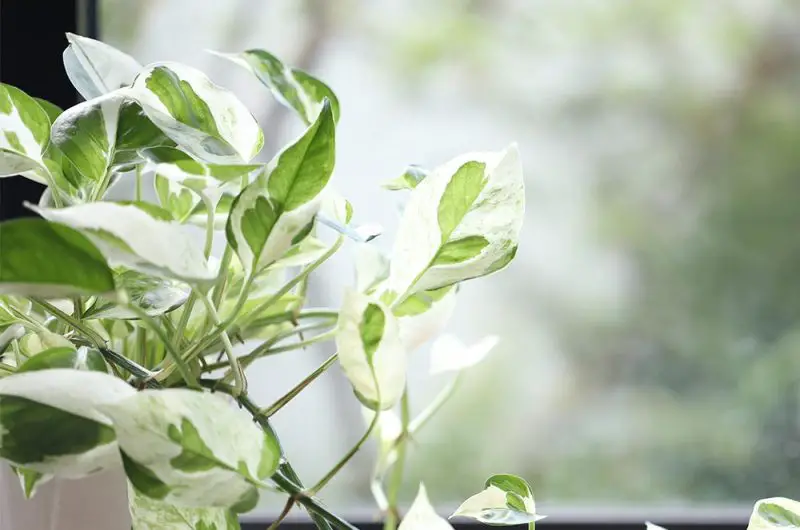
Succulent vines and climbers are a wonderful addition to any garden or indoor plant collection. Not only do they add an interesting texture and dimension to your space, but they are also easy to care for and can thrive in a variety of conditions. Here are the top 10 succulent vines and climbers to consider:
String of Pearls (Senecio rowleyanus)
The string of pearls (Senecio rowleyanus) is a fascinating and unique succulent vine that is native to the arid regions of southwest Africa. It is a member of the Asteraceae family and is also known as the string of beads or bead plant. The plant’s common name comes from the shape of its small, round leaves, which resemble pearls or beads strung together on a necklace.
The string of pearls is a low-maintenance plant that is perfect for indoor cultivation. It thrives in bright, indirect light and prefers well-draining soil. The plant’s leaves are adapted to store water, making it tolerant of drought conditions, but it’s important not to overwater the plant, as this can lead to root rot.
The plant is often grown in hanging baskets or pots, where its trailing stems can cascade over the edge. The plant’s stems can grow up to three feet in length, and the plant can produce small, white flowers in the summer months.
One of the most interesting things about the string of pearls is its ability to propagate easily. The plant produces small, bead-like “pearls” along its stems, which can be removed and planted in soil to grow new plants. This makes the string of pearls a popular plant for sharing with friends or propagating into multiple plants for your own collection.
Burro’s Tail (Sedum morganianum)
Burro’s Tail, also known as Donkey Tail or Horse Tail, is a popular succulent plant with trailing stems covered with overlapping, blue-green leaves. The plant is native to Mexico and is commonly grown as an indoor plant due to its attractive foliage and ease of care.
The plant can grow up to 2 to 3 feet long, and its trailing stems make it an ideal plant for hanging baskets or cascading over the edges of containers. The leaves are about 1 to 2 inches long and can store water, making the plant tolerant of drought conditions. However, overwatering can lead to root rot, so it’s essential to let the soil dry out completely between waterings.
Burro’s Tail prefers bright, indirect light but can tolerate partial shade. It’s important to protect the plant from direct sunlight, especially during the hottest part of the day, as the leaves can get sunburned. In the winter months, the plant may go dormant and may require less water.
To propagate, simply take a stem cutting, let it dry for a day or two, and then plant it in well-draining soil. After a few weeks, new roots will begin to grow, and the plant will start to develop new leaves.
String of Hearts (Ceropegia woodii)
String of Hearts, also known as Ceropegia woodii, is a delicate and graceful succulent vine that is native to South Africa. The plant is a member of the Asclepiadaceae family and is known for its slender, trailing stems covered in small, heart-shaped leaves.
The plant’s leaves are about 0.5 to 1 inch long and come in shades of green and variegated colors, with silver or white stripes on the edges. The stems can grow up to 3 feet long and produce small, tubular flowers in shades of pink or purple in the spring and summer months.
String of Hearts is a low-maintenance plant that is easy to care for and grows well in bright, indirect light. The plant prefers well-draining soil and can tolerate periods of drought, but it’s essential not to overwater the plant, as this can lead to root rot.
To propagate, simply take a stem cutting, let it dry for a day or two, and then plant it in well-draining soil. After a few weeks, new roots will begin to grow, and the plant will start to develop new leaves.
String of Hearts is a popular plant for hanging baskets or trailing over the edges of containers. It’s a great choice for adding some interest and texture to your indoor space, and its delicate leaves and trailing stems make it a beautiful and unique addition to any succulent collection.
Rat Tail Cactus (Aporocactus flagelliformis)
Rat Tail Cactus, also known as Aporocactus flagelliformis, is a unique and unusual succulent vine that is native to Mexico. The plant is a member of the Cactaceae family and is known for its long, trailing stems covered in small, cylindrical leaves that resemble rat tails.
The plant’s stems can grow up to 6 feet long and produce beautiful, pink or red flowers in the spring and summer months. The flowers are about 1 to 2 inches long and tubular in shape, with delicate petals and stamens.
Rat Tail Cactus is a low-maintenance plant that is easy to care for and grows well in bright, indirect light. The plant prefers well-draining soil and can tolerate periods of drought, but it’s important not to overwater the plant, as this can lead to root rot.
To propagate, simply take a stem cutting, let it dry for a day or two, and then plant it in well-draining soil. After a few weeks, new roots will begin to grow, and the plant will start to develop new stems and leaves.
Rat Tail Cactus is a popular plant for hanging baskets or trailing over the edges of containers. It’s a great choice for adding some interest and texture to your indoor space, and its unique cylindrical leaves and trailing stems make it a beautiful and unusual addition to any succulent collection.
Fishbone Cactus (Epiphyllum anguliger)
Fishbone Cactus, also known as Epiphyllum anguliger, is a stunning and unusual succulent vine that is native to Central and South America. The plant is a member of the Cactaceae family and is known for its long, flat, and deeply-lobed leaves that resemble a fishbone.
The plant’s leaves can grow up to 12 inches long and 4 inches wide, with deep, zigzagging indentations along the edges. The leaves are a striking green color, with lighter-colored veins that give the plant a unique and intricate appearance.
Fishbone Cactus produces beautiful, white, or pink flowers that bloom in the late spring and summer months. The flowers are about 6 inches wide and have long, narrow petals that give the plant a delicate and elegant appearance.
Fishbone Cactus is a low-maintenance plant that is easy to care for and grows well in bright, indirect light. The plant prefers well-draining soil and can tolerate periods of drought, but it’s important not to overwater the plant, as this can lead to root rot.
Fishbone Cactus has ability to propagate easily from stem cuttings. To propagate, simply take a stem cutting, let it dry for a day or two, and then plant it in well-draining soil. After a few weeks, new roots will begin to grow, and the plant will start to develop new stems and leaves.
Fishbone Cactus is a popular plant for hanging baskets or trailing over the edges of containers. It’s a great choice for adding some interest and texture to your indoor space, and its unique leaves and beautiful flowers make it a stunning addition to any succulent collection.
Climbing Aloe (Aloe ciliaris)
Climbing Aloe, also known as Aloe ciliaris, is a unique and attractive succulent vine that is native to South Africa. The plant is a member of the Aloe family and is known for its long, trailing stems covered in small, narrow leaves that resemble soft, green needles.
The plant’s stems can grow up to 10 feet long and produce beautiful, bright orange-red flowers in the summer and fall months. The flowers are about 1 to 2 inches long and tubular in shape, with delicate petals and stamens.
Climbing Aloe is a low-maintenance plant that is easy to care for and grows well in bright, indirect light. The plant prefers well-draining soil and can tolerate periods of drought, but it’s important not to overwater the plant, as this can lead to root rot.
Climbing Aloe has ability to climb and attach itself to other plants or surfaces using its small, hair-like roots. This allows the plant to grow vertically, creating a beautiful cascading effect that is perfect for hanging baskets or trailing over the edges of containers.
Climbing Aloe is a great choice for adding some interest and texture to your indoor space, and its unique leaves and beautiful flowers make it a stunning addition to any succulent collection. Its ability to climb also makes it a great plant for creating living walls or green roofs.
Blue Chalksticks (Senecio serpens)
Blue Chalksticks, also known as Senecio serpens, is a stunning and unique succulent vine that is native to South Africa. The plant is a member of the Asteraceae family and is known for its cylindrical, blue-green leaves that resemble chalk sticks.
The plant’s leaves can grow up to 6 inches long and are tightly packed along the stem, giving the plant a dense and bushy appearance. Blue Chalksticks produces small, white, daisy-like flowers that bloom in the summer months, but the plant is primarily grown for its striking foliage.
Blue Chalksticks is a low-maintenance plant that is easy to care for and grows well in full sun or partial shade. The plant prefers well-draining soil and can tolerate periods of drought, but it’s important not to overwater the plant, as this can lead to root rot.
To propagate, simply take a stem cutting, let it dry for a day or two, and then plant it in well-draining soil. After a few weeks, new roots will begin to grow, and the plant will start to develop new stems and leaves.
Blue Chalksticks is a great choice for adding some color and texture to your indoor or outdoor space, and its unique foliage makes it a stunning addition to any succulent collection. The plant is drought-tolerant and can grow well in a variety of climates, making it a popular choice for xeriscaping or water-wise gardening projects.
Climbing Onion (Bowiea volubilis)
Climbing Onion, also known as Bowiea volubilis, is a fascinating and unusual succulent vine that is native to South Africa. The plant is a member of the Asparagaceae family and is known for its long, thin stems that can grow up to 6 feet in length and are covered in small, greenish-white flowers.
The plant’s stems are thin and wiry and are often compared to spaghetti or noodles. They grow in a tangled mass and can be trained to climb or cascade over the edges of pots or trellises. The leaves are small and inconspicuous and grow along the stem in clusters.
Climbing Onion is a low-maintenance plant that is easy to care for and grows well in bright, indirect light. The plant prefers well-draining soil and can tolerate periods of drought, but it’s important not to overwater the plant, as this can lead to root rot.
Climbing Onion has ability to go dormant during periods of drought. When the plant is dormant, it will shed its leaves and the stems will become dry and brittle. However, when watered, the plant will quickly come back to life and produce new leaves and stems.
Climbing Onion is a great choice for adding some interest and texture to your indoor or outdoor space, and its unique stems and small flowers make it a stunning addition to any succulent collection. The plant is drought-tolerant and can grow well in a variety of climates, making it a popular choice for xeriscaping or water-wise gardening projects.





